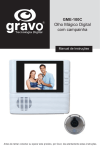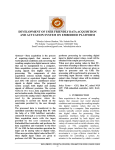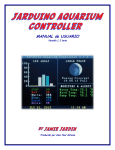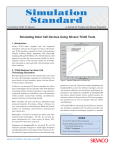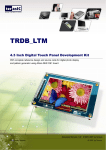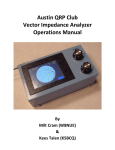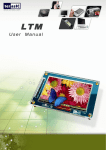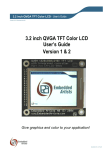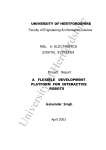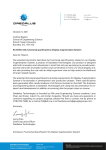Download Resistive Touch Sensor based Graphics Plotter on an Embedded
Transcript
International Journal of Computer Applications (0975 – 8887) International Conference on Information and Communication Technologies (ICICT- 2014) Resistive Touch Sensor based Graphics Plotter on an Embedded Display Padma Prasada Sukesh Rao M E&C Dept. MITE, Moodbidri E&C Dept. NMAMIT, Nitte ABSTRACT Today, many fields are adopting touch screens or touch panels for applications with human/machinery or human/computer interfaces. This paper presents the concepts and methods for the interfacing of touch–screen sensor and TFT LCD Display unit to host microcontroller. Software programming algorithm and their implementation are also portrayed. Resistive touch sensor based graphics plotter is one such hand held embedded device which uses resistive touch panel and TFT LCD Display as an input and output terminals respectively. The implementation methods give special consideration to analog power–down strategies, efficient analog to digital conversion and optimize the touch sensor algorithm. Active Matrix Display of Thin Film Transistor technology is used as an output display unit, it’s being chosen since it is thin, flat and consumes very less amount of power. The method and workflow of resistive touch sensor based graphics plotter is emphasized. In this approach LPC2103 microcontroller from Philips Semiconductor Pvt Ltd, based on ARM7TDMI-S core is used as host controller. The ARM7TDMI-S CPU features 8 A/D channels, 32 general purpose I/O and several power saving modes. Using Cross ware Embedded development Studio, the entire software programming is done in C–language. Keywords ARM7TDMI – S Core, Resistive Touch Screen, active Matrix display, Thin Film transistor, Touch Screen Controller. 1. INTRODUCTION The paper aims in developing a resistive touch sensor based graphics plotter, which accepts user input via resistive touch panel and its being processed by host microcontroller. Touch screens emerged from academics and corporate research labs in the second half of the 1960s. One of the first places where they gained some visibility was in the terminal of a computer–assisted learning terminal that came out in 1972 as part of the PLATO project. The popularity of smart phones, PDAs, portable game consoles and many types of information appliances is driving the demand for, and the acceptance of, touch screens [11]. The LPC2103 microcontrollers are based on a 32–bit ARM7TDMI–S CPU with real time emulation that combines the microcontroller with 32kb of embedded high speed flash memory. Due their tiny size and low power consumption, LPC2103 are ideal for applications where miniaturization is a key requirement. Hence it is used as host controller in this project, accepts input from resistive touch sensor, which is processed by this host controller and, drives a TFT LCD display unit. Modern industrial products in the current market are increasingly using LCD panels to provide a more sophisticated visual interface for the user. These panels have evolved into units that are easy to work with, bright, have high contrast, and come in a wide variety sizes. The most popular LCD panels are the Amorphous Silicon Thin Film Transistor or a–SiTFT panels. We use a TFT_320QVT TFT LCD display module to plot graphics, which is drawn by user on resistive touch sensor using stylus. It is controlled and driven by SSD1289 LCD controller driver. SSD1289 is all in one TFT LCD driver that has integrated RAM, power circuits, gate driver and source driver into single chip. It can drive up to 262K color with resolution of 240x320. The rest of this paper is organized as follows: section II describes the proposed system configuration and its architecture and functionality. Section III exposes hardware design and interface technique. It includes interfacing of 4-wire Resistive Touch screen and interfacing of TFT LCD display with ARM7TDMI-S CPU. In section IV, software implementation method and workflow of the system is portrayed. Section V concludes this paper. 2. SYSTEM CONFIGURATION AND ARCHITECHTURE The proposed system consist a 4–wire resistive touch screen, host controller i.e. ARM7TDMI–S CPU and a TFT LCD display module. As user writes over touch screen, resistive touch screen produces corresponding touch position dependent analog voltage. Resistive touch screen is controlled and driven by ARM7TDMI– S CPU; it receives analog voltage output from resistive touch screen, and converts it into corresponding machine understandable digital logic level to identify the touch point on the touch screen. Its functional block diagram is represented in Fig 1. 4 – Wire Resistive Touch Screen 4 - Wire interface Host Controller (Atmega 2560) 18 Bit TFT LCD Display Module Fig 1: Block diagram of proposed system On the output side, host microcontroller drives TFT LCD display. TFT LCD display is used to display the reproduced graphics, which inputted via Resistive Touch screen. TFT LCD display unit has integrated LCD driver IC SSD1289 from Solomon Systech Limited. Once the touch point on resistive touch screen has been identified, its coordinates are being mapped on to TFT LCD display for displaying user interpreted graphics. Interfacing technique for resistive touch screen and TFT LCD display with ARM7TDMI-S CPU is discussed in next section 3. HARDWARE DESIGN AND INTERFACE TECHNIQUE In an embedded system development power consumption is a critical issue to be considered. In our approach, we give special consideration to analog power-down strategies like de-activating unused on-chip peripherals of host controller, and implementation of efficient analog to digital conversion. 37 International Journal of Computer Applications (0975 – 8887) International Conference on Information and Communication Technologies (ICICT- 2014) Touch screen controller is the key to this design. Currently there are variety of microcontrollers are available in market. Considering price, speed and flexibility and other factors, a high cost-effective chip LPC2103 based on ARM7TDMI-S CPU of Philips Semiconductors Pvt Ltd is used. LPC2103 includes an 8 analog to digital conversion channels with conversion time as low as 2.44u Sec, which is key requirement to implement touch screen controller, and also 32 general purpose input / output ports along with, multiple serial interfaces including UARTs, I2C buses, SPI and SSP. Of all the kinds of touch screens available, resistive touch screens are easy to interface, cost effective and they have fair sensitivity. Resistive Touch screens are simple transducers. This touch screen has a resistive layers in both X and Y directions. According to the position of the touch, their X coordinate and Y coordinate resistance changes. So, we have to measure the X and Y coordinates resistance to get the position of the touch in terms of X and Y coordinate position. Fig 2 gives the simple structure of resistive Touch Screen. To interface resistive Touch screen with a host microcontroller, we need a microcontroller with inbuilt Analog-to-Digital converter. ARM7TDMI-S CPU provides eight Analog-to-Digital converter channels, out of this two channels are utilized for this purpose. To read the position of the touch, we have to first read touch position sequentially i.e. first read X position and then read Y position. To do this, we connected X1 and Y2 pins of Touch screen to ADC multiplexed GPIO pins of LP2103, i.e. P0.22 and P0.23 respectively. And X2 and Y1 pins of Touch screen to simple GPIO pins of LPC2103, i.e. P0.20 and P0.22 respectively. TFT LCDs are class of Active Matrix displays, belong to type of flat-panel display in which the screen is refreshed more frequently than in conventional Passive Matrix display, and uses individual transistors to control the charges on each cell in the liquid-crystal layer. The silicon transistor matrix in a TFT is typically composed of amorphous silicon (a-Si). They have good color, good greyscale reproduction, and fast response [9]. Interfacing of TFT LCD display module with ARM7TDMI-S CPU is done using Parallel 6800-series Interface technique. The Parallel interface consists of 18 bi-directional data pins D[17:0],𝑅/𝑊 , D/𝐶 , E and𝐶𝑆. 𝑅/𝑊 input HIGH indicates a read operation from the Graphical Display Data Ram i.e. GDDRAM. 𝑅/𝑊 input LOW indicates a write operation to Display Data RAM. The E input serves as data latch signal when 𝐶𝑆 is LOW [6] [12]. The data lines DB0-DB7 and DB8-DB15 of TFT LCD module is connected to P0.8-P0.15 and P0.24-P0.31 of ARM7TDMI-S CPU respectively. Note that two bits are discarded, since 8-bits per color are used. Control signal lines RS, WR, RD, CS and RESET pins are interfaced to simple General purpose Input / Output Ports of host controller. Implementation method and workflow of implementation will be discussed in next section. 4. IMPLEMENTATION METHOD AND WORKFLOW Implementation consists two phases, controlling and reading touch position coordinates and simultaneously mapping the Touch position coordinates to TFT LCD display. Implementation work carried out on ARM7TDMI-S CPU using Crossware Embedded Development Studio. Crossware’s Embedded Development Studio leverages the features of windows to provide a development environment that allows the programmer to concentrate on the primary task of software development. 4.1. Touch Screen Controller The 4-Wire Resistive Touch Screen is interfaced to ARM7TDMI-S CPU as explained in previous section. Used two ADC multiplexed General Purpose Input / output pins for reading X and Y Touch position coordinates and two simple General Purpose input / Output pins for driving power signals. As stated earlier, first have to read X position of the Touch, for that, pin X1 of Touch Screen is programmed as Logic HIGH (+3.3volts) and Configured X2 as logic LOW (ground). Resistive Touch Screen contains a resistive layer in both directions. So, when we apply Logic HIGH and Logic LOW to its pins, it will create a voltage gradient in X direction. Voltage on the X channel will vary according to the Touch position. Measure this voltage to determine the X position. For this purpose, Y2 is connected to ADC input and Y1 is kept at HIGH impedance state. The value of ADC output will be relative value of the Touch. After reading X position, now have to read the Y position to determine the Touch position. To read Y position Y2 is programmed as Logic HIGH, Y2 as Logic LOW, and X1 as ADC input and X2 as HIGH impedance state. TABLE 1 illustrates the 4-wire resistive touch screen interfacing configuration. The entire procedure explained above must be repeated continuously to determine Touch position instantaneously. TABLE 1 Resistive Touch Screen Interfacing Configuration ARM7TDMI-S Port Pins Resistive Touch Screen Pins Pin Assignment for X-Position Pin Assignment for YPosition P0.20 Y1 No Connection +3.3volts P0.21 X2 Ground No Connection P0.22 Y2 ADC Input Ground P0.23 X1 +3.3volts ADC Input Fig2: Four-wire Resistive Touch Screen 38 International Journal of Computer Applications (0975 – 8887) International Conference on Information and Communication Technologies (ICICT- 2014) The Pen Interrupt feature is implemented with a simple analog circuit, schematic is shown in Figure 4. By simply pulling-up the output pin of resistive Touch Screen to Vcc through series connected diode, a basic interrupt function can be implemented. While the Touch screen is untouched, the diode is not biased, and no current will flow. The voltage level at point A will be approximately Vcc. START Initialize all peripherals like GPIO, ADC etc TouchScreen_Config (); N Pen Interrupt = LOW? NO YES Create Voltage Gradient in X direction and Connect Y2 as ADC input Tp_X=Read_X (); Fig3: Configuration to read X and Y Touch position Create Voltage Gradient in Y direction and Connect X1 as ADC input Tp_Y=Read_Y (); When the Touch screen is pressed, the diode is forward biased and current flows to complete this current loop to ground. Now, the voltage at point A is pulled LOW. The low going voltage level at point A can be used as interrupt to host controller to perform analog-to-digital conversion [13]. Determine the Touch Position on the Touch Screen Repeat Fig5: Touch Screen reading work flow 4.2. TFT LCD Display programming The term Liquid Crystal is used to describe a substance is a state between liquid and solid, but which exhibits the properties of both. Molecules in liquid crystals tend to arrange themselves until they all point in the same specific direction. This arrangement of molecules enables the medium to flow as a liquid. Liquid crystal in a nematic phase, are used in LCD technology [9]. We use TFT_320QUT LCD Display module in this approach. TFT LCD display uses a grid of transistors with the ability to hold a charge for a limited period of time; only desired pixel receives charge and hence improved image quality. TFT_320QUT TFT LCD module is controlled and driven by SSD1289 TFT controller driver. This module is interfaced with ARM7TDMI-S CPU by using Parallel 6800-Series interface technique as discussed in section III. Timing cycles for parallel 6800-series interface is illustrated in Fig 6. Figure 4.Schematic for PENIRQ generating technique Fig 5 describes the work flow of driving and reading resistive touch Screen, to determine the Touch position coordinates. Once host controller determines Touch position on Resistive touch Screen, it will be taken as initial Touch position and, it’s mapped on to TFT LCD Display. Next obtained Touch position is compared with previous Touch position, to determine the direction of user pen movement on Resistive Touch Screen. In this way Resistive Touch screen touch position coordinates are mapped on to TFT LCD display. 39 International Journal of Computer Applications (0975 – 8887) International Conference on Information and Communication Technologies (ICICT- 2014) 5. VALIDATION AND EXPERIMENTAL RESULTS Fig6: Timing Waveform of Parallel 6800-Series Interface There is sequence of operation to be performed to initialize the TFT LCD. SSD1289 driver controller contains several command registers. It’s necessary to write those register in sequence, describing desired display mode, power setting, mode of interface etc. Fig 7 gives the work flow of initialising of TFT LCD display module. The validation is performed in two steps; first touch screen controller is implemented on target board using Crossware Embedded Development Studio as explained in section IV. Its response is being verified on windows hyper terminal connected via two wire Rx and Tx ports of UART0 of the host controller. Fig 8 shows the output values obtained on windows hyper terminal for touch event as its co-ordinate values and untouch event is represented by zeros. For the touch event the X and Y coordinates are found as explained with the help of fig 5. First, the voltage gradient is created for X axis and coordinate value is converted using in-built ADC. Repeated same procedure for Y axis coordinates estimation by creating voltage gradient to Yaxis. The obtained values are send to windows hyper terminal through UART protocol and verified for various touch positions. Fig 9 gives the implementation result for resistive touch sensor based graphics plotter. The graphics is reproduced and displayed on TFT LCD display as user writes over touch screen. Power Supply setting Display Control Setting Set Oscillation Start Bit Set Display ON Bit of Command Register R07h Exit from Sleep Mode by Setting Sleep Mode Exit Bit of R10h Fig 8: Windows hyper terminal window Wait for 30ms Entry Mode Setting LCD Driver and AC Setting Write Data into Graphic Display Data Ram (GDDRAM) Display ON Fig 9: Implementation Result Fig 7: LCD Power ON Sequence 40 International Journal of Computer Applications (0975 – 8887) International Conference on Information and Communication Technologies (ICICT- 2014) 6. CONCLUSION The 4-Wire Resistive Touch Screen interfacing with ARM7TDMI-S CPU is designed, implemented and tested. Windows hyper Terminal is being used for testing the corresponding Touch coordinate values obtained as Touch position on a Resistive Touch Screen. Measurements are made by applying voltage gradient across one of the layer and measuring the voltage on the other layer. This measurement is made twice, once with the gradient across the ridged layer and the measurement taken from the flexible layer and again with the gradient applied to the flexible layer and the measurement taken from the ridged layer. The resistance of the bus bars and the connection circuitry introduces an error (offset) in the voltage measurement. These offsets can also drift, with changes in temperature, humidity and time. So calibrating the screen periodically is to be done or can utilize 8-wire Touch Screen. And non-linear response exists when the contact between the two layers is not good. The nonlinearity exists mainly when the level pressure is not enough. In this paper we also present TFT LCD interfacing technique with the ARM7TDMI-S CPU. Parallel 6800-Series Interfacing technique is illustrated and implemented on host microcontroller. Currently we are working on mapping of Touch position coordinates onto the TFT LCD. There is also an option to integrate a Micro SD card with this system. With this enhanced feature user can display particular image file or data file stored on Micro SD card, along with the Touch input. A real-life equivalent of the system prototype presented in this paper can be developed with minimal development cost and relatively low operational cost. 7. REFERENCES [1] [2] “Programming Techniques” issued June 1995 © Advanced RISC Machines Ltd 1995 [3] “ARM Architecture Reference Manual” issued 2005 © Advanced RISC Machines Ltd (ARM) 2005 [4] “Touch Screen Control and Calibration -- Four-Wire, Resistive” Application Note By CYPRESS MICROSYSTEMs [5] “Resistive Touch screen Controller Using the S08 Family” Application Note Freescale Semiconductor © Freescale Semiconductor, 2010 [6] “240 RGB x 320 TFT LCD Controller Driver integrated Power Circuit, Gate and Source Driver with built-in RAM” Copyright © 2007 Solomon Systech Limited [7] “Touch Panel Integration Guide” Newhaven Display International, Inc. [8] “LPC2101/02/03 User Manual” Philips Semiconductors [9] “Fundamentals of Liquid Crystal Displays – How They Work and What They Do” FUJITSU MICROELECTRONICS AMERICA, INC. [10] “Practical C Programming”. 3rd Oualline, O'Reilly Media Edition, By Steve [11] http://en.wikipedia.org/wiki/PLATO_%28computer_system %29 [12] “SPI, Intel 8080, and Motorola 6800 communication protocol between MCU and OLED driver” Semiconductors, Application Note, May 2005 Opto [13] “Touch Screen Controller Tips” Application Bulletin By Skip Osgood, CK Ong, and Rick Downs © Burr-Brown Corporation 2000 R.N. Aguilar, G.C.M. Meijer “Fast Interface Electronics for a Resistive Touch-Screen” IEEE J 2000 41





